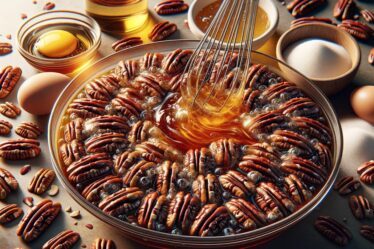
Pappardelle is a type of wide, flat pasta originating from the Tuscany region of Italy. The name is derived from the Italian verb “pappare,” meaning “to gobble up.” This pasta variety is known for its versatility and can be paired with numerous sauces and ingredients, making it a popular choice in Italian cuisine. Typically made with flour and eggs, pappardelle has a rich flavor and substantial texture.
Its wide shape and slightly rough surface are ideal for holding thick, hearty sauces, contributing to its popularity in comforting and satisfying dishes. The pasta’s distinctive appearance and texture make it suitable for both casual meals and more formal dining occasions. Its wide ribbons create an visually appealing presentation, making it a favored option for dinner parties and special events.
Pappardelle’s combination of traditional origins and adaptability to various recipes has secured its place as a staple in Italian cooking. Its popularity has spread beyond Italy, becoming increasingly common in kitchens around the world.
Key Takeaways
- Pappardelle pasta is a wide, flat pasta that originated in Tuscany, Italy and is known for its versatility in pairing with various sauces and ingredients.
- The key ingredients for savory pappardelle pasta include pappardelle noodles, olive oil, garlic, fresh herbs, salt, and pepper, as well as optional ingredients such as mushrooms, tomatoes, and cheese.
- Cooking pappardelle pasta involves boiling the noodles in salted water until al dente, then draining and tossing with olive oil to prevent sticking.
- Tips for perfectly cooked pappardelle pasta include using a large pot for boiling, salting the water generously, and testing for doneness before draining.
- Savory flavors can be added to pappardelle pasta through the use of ingredients such as pancetta, sausage, seafood, and a variety of vegetables, as well as different types of sauces such as tomato-based, cream-based, or pesto.
Ingredients for Savory Pappardelle Pasta
Basic Ingredients
– 2 cups of all-purpose flour
– 3 large eggs
– 1 tablespoon of olive oil
– 1 teaspoon of salt
These simple ingredients come together to create a rich and flavorful pasta that is perfect for pairing with a variety of sauces and ingredients. The all-purpose flour provides the base for the pasta, while the eggs add richness and flavor. The addition of olive oil and salt helps to enhance the overall taste and texture of the pasta, making it a delicious and satisfying dish.
Experimenting with Flavors
If you’re feeling adventurous, you can also experiment with adding different flavors to your pappardelle pasta. For example, you could try adding herbs like basil or parsley to the dough for a fresh and aromatic twist. You could also incorporate ingredients like spinach or tomato paste to create colorful and flavorful variations of pappardelle pasta.
Customizing to Your Taste
The possibilities are endless when it comes to customizing your pappardelle pasta to suit your taste preferences.
Step-by-Step Instructions for Cooking Pappardelle Pasta

1. Start by making the pasta dough. On a clean work surface, mound the flour and create a well in the center.
Crack the eggs into the well and add the olive oil and salt. 2. Using a fork, gradually incorporate the flour into the eggs until a dough begins to form.
Once the dough starts to come together, knead it with your hands until it becomes smooth and elastic. 3. Wrap the dough in plastic wrap and let it rest at room temperature for at least 30 minutes.
4. After the dough has rested, roll it out into a thin sheet using a rolling pin or pasta machine. 5.
Once the dough is rolled out, cut it into wide strips to create the pappardelle noodles. 6. Bring a large pot of salted water to a boil and add the pappardelle noodles.
Cook for 3-5 minutes, or until the noodles are al dente. 7. Drain the noodles and toss them with your favorite sauce or ingredients.
8. Serve the pappardelle pasta hot and enjoy!
Tips for Perfectly Cooked Pappardelle Pasta
| Tip | Description |
|---|---|
| Use a large pot | Choose a pot that is large enough to hold the pasta without crowding. |
| Generously salt the water | Add salt to the boiling water before adding the pasta to enhance the flavor. |
| Stir the pasta | Stir the pasta immediately after adding it to the boiling water to prevent sticking. |
| Check for doneness | Regularly taste the pasta to check for the perfect texture. |
| Reserve pasta water | Save some of the pasta cooking water to use in the sauce for added flavor and texture. |
| Finish cooking in the sauce | Transfer the cooked pasta directly to the sauce and finish cooking it there for better flavor absorption. |
– Use fresh eggs: Fresh eggs will give your pappardelle pasta a rich and flavorful taste.
– Don’t overwork the dough: Be careful not to over-knead the dough, as this can result in tough and chewy pasta.
– Roll out the dough evenly: Make sure to roll out the dough into an even thickness so that the noodles cook evenly.
– Cook al dente: Be sure to cook the pappardelle noodles until they are al dente, or firm to the bite, for the best texture.
– Toss with sauce immediately: Once the noodles are cooked, toss them with your sauce or ingredients right away to prevent them from sticking together. By following these tips, you can ensure that your pappardelle pasta turns out perfectly cooked and delicious every time.
Adding Savory Flavors to Pappardelle Pasta
Pappardelle pasta is incredibly versatile and can be paired with a wide range of savory flavors to create delicious and satisfying dishes. One classic way to enjoy pappardelle is with a rich and hearty meat sauce, such as a traditional Bolognese or ragu. The wide shape of the pappardelle noodles makes them perfect for holding onto chunky and flavorful sauces, creating a comforting and satisfying meal.
If you’re looking for a lighter option, you can also pair pappardelle with seafood, such as shrimp or scallops, for a fresh and flavorful dish. The wide noodles provide a perfect base for showcasing the delicate flavors of seafood, creating an elegant and impressive meal that is sure to impress your guests. For a vegetarian option, you can pair pappardelle with roasted vegetables, such as mushrooms, zucchini, or bell peppers, for a colorful and flavorful dish that is both satisfying and nutritious.
The wide shape of the pappardelle noodles provides the perfect canvas for showcasing the natural flavors of the vegetables, creating a delicious and wholesome meal that is perfect for any occasion.
Serving and Presentation of Pappardelle Pasta

Flavorful Pairings
To start, pair your pappardelle with a complementary sauce or ingredients that will elevate the overall flavor of the dish. Whether you opt for a rich meat sauce, delicate seafood, or vibrant vegetables, be sure to toss the pappardelle with your chosen ingredients just before serving to ensure each bite is packed with flavor.
Presentation Perfection
In terms of presentation, consider garnishing your pappardelle pasta with fresh herbs like basil or parsley to add a burst of color and freshness to the dish. You can also sprinkle freshly grated Parmesan cheese over the top for added richness and flavor.
Serving Suggestions
When serving, consider using shallow bowls or large plates to showcase the wide noodles and allow your guests to fully appreciate the beauty of this delicious pasta.
Variations and Substitutions for Pappardelle Pasta
While traditional pappardelle pasta is made with all-purpose flour and eggs, there are many variations and substitutions that you can experiment with to create unique and flavorful dishes. For example, you can try using whole wheat flour or semolina flour in place of all-purpose flour for a nutty and hearty flavor. You can also experiment with using different types of eggs, such as duck eggs or quail eggs, for a richer and more unique taste.
If you’re looking to add more flavor to your pappardelle pasta, consider incorporating ingredients like herbs, spices, or vegetables into the dough itself. For example, you could try adding chopped spinach or sun-dried tomatoes to create colorful and flavorful variations of pappardelle pasta. You could also experiment with using different types of oils, such as truffle oil or herb-infused oils, to add depth and complexity to the flavor of the pasta.
In terms of substitutions, you can also experiment with using different types of sauces or ingredients to pair with your pappardelle pasta. For example, you could try using creamy Alfredo sauce in place of traditional tomato-based sauces for a rich and indulgent dish. You could also experiment with using different types of proteins, such as chicken or sausage, to create hearty and satisfying variations of pappardelle pasta.
Overall, there are endless possibilities when it comes to variations and substitutions for pappardelle pasta, so don’t be afraid to get creative and experiment with different flavors and ingredients to create unique and delicious dishes that are sure to impress!
If you’re a fan of Mediterranean cuisine, you’ll love this recipe for pappardelle pasta with a rich and flavorful sauce. And if you’re looking for a refreshing beverage to pair with it, check out this article on exploring the Mediterranean medlar here. The unique flavor of the medlar fruit makes it a perfect complement to the bold flavors of the pasta dish.
FAQs
What is pappardelle pasta?
Pappardelle is a type of pasta that is wide and flat, similar to fettuccine. It is typically made with eggs and all-purpose flour, and is commonly used in Italian cuisine.
What are some common ingredients used in a recipe with pappardelle pasta?
Common ingredients used in a recipe with pappardelle pasta include olive oil, garlic, tomatoes, basil, Parmesan cheese, and various proteins such as chicken, shrimp, or pancetta.
How is pappardelle pasta typically cooked?
Pappardelle pasta is typically cooked in a large pot of boiling salted water until it is al dente, which means it is cooked through but still firm to the bite. It is then drained and often added to a sauce or other ingredients.
What are some popular recipes that use pappardelle pasta?
Popular recipes that use pappardelle pasta include Pappardelle with Bolognese sauce, Pappardelle with Mushroom Cream Sauce, and Pappardelle with Lemon and Herb Chicken.
Can pappardelle pasta be substituted with other types of pasta in a recipe?
Yes, pappardelle pasta can be substituted with other wide and flat pasta such as fettuccine or tagliatelle in a recipe. However, the texture and mouthfeel of the dish may be slightly different.



